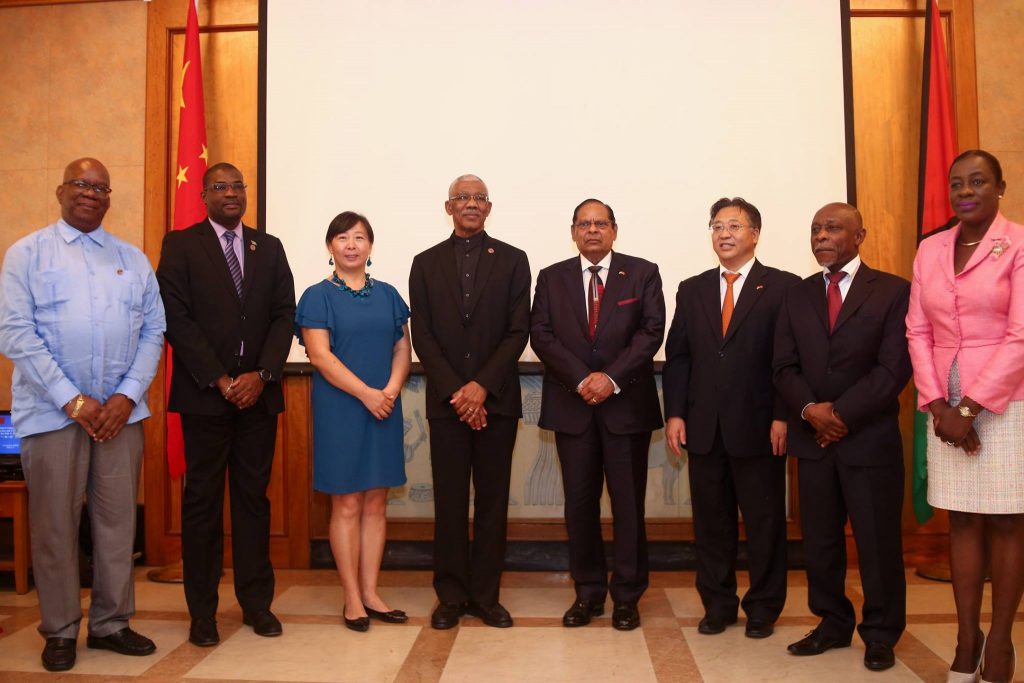
By Bibi Khatoon
In observance of 48 years of diplomatic relations, the Government of Guyana today signed onto China’s ‘Belt and Road’ initiative.
Guyana is the 74th country to sign onto the massive trade and infrastructure project that aims to link China — physically and financially –with the rest of the world.
The Cooperation agreement was signed by Guyana’s Foreign Minister, Carl Greenidge and China’s Ambassador to Guyana, Cui Jianchun in the presence of President David Granger; Prime Minister, Moses Nagamootoo; Finance Minister, Winston Jordan and other senior Government Ministers at the Chinese Embassy at Mandela Avenue, Georgetown.
While 73 countries in Asia, Europe and Africa signed onto the agreement launched in 2013, Guyana is the first country in the Caribbean and South America to formalize its commitment to the project.
CARICOM recently signaled its interest in the initiative to ascertain how the region’s goals and priorities can be best linked to that of the East Asian country’s project.
Greenidge told the media that Guyana is particularly interested in infrastructure development as well as access to funding from the East Asian Country to build such facilities.
The Minister described Guyana’s infrastructure as “grossly inadequate” which he said has served as a constraint to investment and the attraction of economic opportunities.
“One of our main priorities at this point in time is to work on the development of infrastructure,” Greenidge told reporters.
The China-LAC Cooperation Fund (hereinafter referred to as “the Fund”) is initiated by the Chinese Government with an investment of 5 billion USD by Chinese institutions.
The Minister said the China’s ‘Belt and Road’ initiative “provides another occasion on which to look beyond our immediate vicinity and our traditional metropolis to the vast potential and economic space that lies also in the east.”
The areas earmarked for cooperation comes under five headings: policy coordination, Facilities connectivity, Unimpeded Trade, Financial integration and People to people bond.
China’s Ambassador to Guyana noted that the two countries started off its partnership in 1972 by pushing political cooperation but has now expanded to pushing people-to-people benefits.
“We are embarking on a new path leading to greater friendship, shared development, peace, harmony and better future,” he told those gathered at the Chinese Embassy.
Meanwhile, asked about cooperation on the topical Linden-Lethem road and the new Demerara Harbour Bridge, the Foreign Minister disclosed that seven Chinese companies have so far bid for the construction of the bridge.
As it relates to the road, Greenidge said during the Government’s earliest discussions with Brazil, it looked at utilizing funds from the China-Latin American Cooperation fund to complete the Kurupukari to Lethem phase as it continues to seek funding.
Under the ‘Belt and Road’ initiative, China is building a network of railroads and shipping lanes linking itself with as many countries as possible. According to international reports, the main focuses of the project are in infrastructure, transportation, and energy.
The “Belt” recreates an old Silk Road land route –an ancient land route across Europe and Asia that was used by traders and travellers from regions like the China, Persia, and the Roman Empire to transport silk and other commodities by camel or horse –while the “Road” is a route through various oceans.
Reports are that China has invested at least US$900 billion in projects along the belt and road including a gas pipeline in Pakistan, a motorway in Hungary, and a high-speed rail link in Thailand.

The project has its critics with some saying the initiative is actually a series of exclusive bilateral deals between China and other economies but is touted as a multilateral project which would violate EU standards.
To operationalise the Memorandum of Understanding with Guyana, it was explained that intended projects will be pushed by both governments through the Embassies.
Guyana and China established relations on June 27, 1972.
Chinese nationals have since been contributing to Guyana in the areas of health through its medical brigades to the South American country, infrastructure through the building of major projects such as the Arthur Chung Conference Centre and the trade among others.






